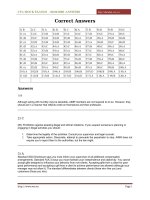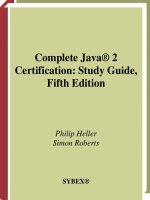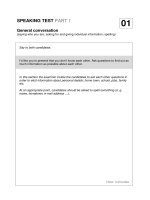Java Programmer Certification Mock Exam
Bạn đang xem bản rút gọn của tài liệu. Xem và tải ngay bản đầy đủ của tài liệu tại đây (215.99 KB, 34 trang )
Java Programmer Certification Mock Exam
No 1
Last Updated 17 Oct 2000
This is my mock Exam No 1 based on the Objectives for the Sun Java Programmers Exam. It was created by Marcus
Green () and may be freely distributed so long as it is unmodified. Please email me if you
have any corrections or comments, but please read this document first
If you obtained this exam from some other source please email me to let me know and check out the latest version at
It really does come with answers
Yes, this is a long document (around 35 pages), if you cannot see the answers then you have not got the entire
document, try reloading it untill you can see the answer to Question 60 and the words "End of document". The
answers contain references to approximately which objective the question relates to. If you have a query about any
of these questions, please, please include the full answer with the question.
Why not discuss this exam with other people ?
You can post a message on the discussion forum at (scroll down the messages to find the
create new conversation button). You could also send me your question but I get heaps of email and my answer is
likely to be slow and terse.
How does this compare with the real thing?
As of 5 Oct 200 the question format has changed very slightly. You will now get more questions that include
snippets (though the ratio may be similar to this mock exam). Each question will also tell you how many of the
options you need to pick. You can read more about these revisions at
You should assume that the real thing will be harder though many people have told me that they get similar marks in
the real thing to my exams..
Where can you find other Mock Exams?
Check out my FAQ at for links to other mock exams You will find links to
many good mock exams that add up to hundreds of questions. You can check out my second mock exam that
contains 60 question at />If you think you have found an error:-
Please include which exam you are referring to, ie 1 or 2 (and maybe soon 3)
Read the questions carefully
I have tried to make the questions unambiguous (the meaning should be obvious), but make sure you have read what
I have written now what you think I might have written. Thus if it says "Classes can be declared with the private
modifier ", it means It is possible to declare a class with the private modifier and not that all classes in all situations
can be declared as private. Each question may have one or more correct Answers.
Questions
Question 1)
Which of the following lines will compile without warning or error.
1) float f=1.3;
2) char c="a";
3) byte b=257;
4) boolean b=null;
5) int i=10;
Answer to Question 1
Question 2)
What will happen if you try to compile and run the following code
public class MyClass {
public static void main(String arguments[]) {
amethod(arguments);
}
public void amethod(String[] arguments) {
System.out.println(arguments);
System.out.println(arguments[1]);
}
}
1) error Can't make static reference to void amethod.
2) error method main not correct
3) error array must include parameter
4) amethod must be declared with String
Answer to Question 2
Question 3)
Which of the following will compile without error
1)
import java.awt.*;
package Mypackage;
class Myclass {}
2)
package MyPackage;
import java.awt.*;
class MyClass{}
3)
/*This is a comment */
package MyPackage;
import java.awt.*;
class MyClass{}
Answer to Question 3
Question 4)
A byte can be of what size
1) -128 to 127
2) (-2 power 8 )-1 to 2 power 8
3) -255 to 256
4)depends on the particular implementation of the Java Virtual machine
Answer to Question 4
Question 5)
What will be printed out if this code is run with the following command line?
java myprog good morning
public class myprog{
public static void main(String argv[])
{
System.out.println(argv[2])
}
}
1) myprog
2) good
3) morning
4) Exception raised: "java.lang.ArrayIndexOutOfBoundsException: 2"
Answer to Question 5
Question 6)
Which of the following are keywords or reserved words in Java?
1) if
2) then
3) goto
4) while
5) case
Answer to Question 6
Question 7)
Which of the following are legal identifiers
1) 2variable
2) variable2
3) _whatavariable
4) _3_
5) $anothervar
6) #myvar
Answer to Question 7
Question 8)
What will happen when you compile and run the following code?
public class MyClass{
static int i;
public static void main(String argv[]){
System.out.println(i);
}
}
1) Error Variable i may not have been initialized
2) null
3) 1
4) 0
Answer to Question 8
Question 9)
What will happen if you try to compile and run the following code?
public class Q {
public static void main(String argv[]){
int anar[]=new int[]{1,2,3};
System.out.println(anar[1]);
}
}
1) 1
2) Error anar is referenced before it is initialized
3) 2
4) Error: size of array must be defined
Answer to Question 9
Question 10)
What will happen if you try to compile and run the following code?
public class Q {
public static void main(String argv[]){
int anar[]=new int[5];
System.out.println(anar[0]);
}
}
1) Error: anar is referenced before it is initialized
2) null
3) 0
4) 5
Answer to Question 10
Question 11)
What will be the result of attempting to compile and run the following code?
abstract class MineBase {
abstract void amethod();
static int i;
}
public class Mine extends MineBase {
public static void main(String argv[]){
int[] ar=new int[5];
for(i=0;i < ar.length;i++)
System.out.println(ar[i]);
}
}
1) a sequence of 5 0's will be printed
2) Error: ar is used before it is initialized
3) Error Mine must be declared abstract
4) IndexOutOfBoundes Error
Answer to Question 11
Question 12)
What will be printed out if you attempt to compile and run the following code ?
int i=1;
switch (i) {
case 0:
System.out.println("zero");
break;
case 1:
System.out.println("one");
case 2:
System.out.println("two");
default:
System.out.println("default");
}
1) one
2) one, default
3) one, two, default
4) default
Answer to Question 12
Question 13)
What will be printed out if you attempt to compile and run the following code?
int i=9;
switch (i) {
default:
System.out.println("default");
case 0:
System.out.println("zero");
break;
case 1:
System.out.println("one");
case 2:
System.out.println("two");
}
1) default
2) default, zero
3) error default clause not defined
4) no output displayed
Answer to Question 13
Question 14)
Which of the following lines of code will compile without error
1)
int i=0;
if(i) {
System.out.println("Hello");
}
2)
boolean b=true;
boolean b2=true;
if(b==b2) {
System.out.println("So true");
}
3)
int i=1;
int j=2;
if(i==1|| j==2)
System.out.println("OK");
4)
int i=1;
int j=2;
if(i==1 &| j==2)
System.out.println("OK");
Answer to Question 14
Question 15)
What will be output if you try to compile and run the following code, but there is
no file called Hello.txt in the current directory?.
import java.io.*;
public class Mine {
public static void main(String argv[]){
Mine m=new Mine();
System.out.println(m.amethod());
}
public int amethod() {
try {
FileInputStream dis=new FileInputStream("Hello.txt");
}catch (FileNotFoundException fne) {
System.out.println("No such file found");
return -1;
}catch(IOException ioe) {
} finally{
System.out.println("Doing finally");
}
return 0;
}
}
1) No such file found
2 No such file found ,-1
3) No such file found, Doing finally, -1
4) 0
Answer to Question 15
Question 16)
Which of the following statements are true?
1) Methods cannot be overriden to be more private
2) Static methods cannot be overloaded
3) Private methods cannot be overloaded
4) An overloaded method cannot throw exceptions not checked in the base class
Answer to Question 16
Question 17)
What will happen if you attempt to compile and run the following code?
1) Compile and run without error
2) Compile time Exception
3) Runtime Exception
class Base {}
class Sub extends Base {}
class Sub2 extends Base {}
public class CEx{
public static void main(String argv[]){
Base b=new Base();
Sub s=(Sub) b;
}
}
Answer to Question 17
Question 18)
Which of the following statements are true?
1) System.out.println( -1 >>> 2);will output a result larger than 10
2) System.out.println( -1 >>> 2); will output a positive number
3) System.out.println( 2 >> 1); will output the number 1
4) System.out.println( 1 <<< 2); will output the number 4
Answer to Question 18
Question 19)
You are browsing the Java HTML documentation for information on the
java.awt.TextField component. You want to create Listener code to respond to focus
events. The only Listener method listed is addActionListener. How do you go about
finding out about Listener methods?
1) Define your own Listener interface according to the event to be tracked
2) Use the search facility in the HTML documentation for the listener needed
3) Move up the hierarchy in the HTML documentation to locate methods in base
classes
4) Subclass awt.event with the appropriate Listener method
Answer to Question 19
Question 20)
What will be displayed when you attempt to compile and run the following code
//Code start
import java.awt.*;
public class Butt extends Frame{
public static void main(String argv[]){
Butt MyBut=new Butt();
}
Butt(){
Button HelloBut=new Button("Hello");
Button ByeBut=new Button("Bye");
add(HelloBut);
add(ByeBut);
setSize(300,300);
setVisible(true);
}
}
//Code end
1) Two buttons side by side occupying all of the frame, Hello on the left and Bye on
the right
2) One button occupying the entire frame saying Hello
3) One button occupying the entire frame saying Bye
4) Two buttons at the top of the frame one saying Hello the other saying Bye
Answer to Question 20
Question 21)
What will be output by the following code?
public class MyFor{
public static void main(String argv[]){
int i;
int j;
outer:
for (i=1;i <3;i++)
inner:
for(j=1; j<3; j++) {
if (j==2)
continue outer;
System.out.println("Value for i=" + i + " Value for j="
+j);
}
}
}
1) Value for i=1 value for j=1
2) Value for i=2 value for j=1
3) Value for i=2 value for j=2
4) Value for i=3 value for j=1
Answer to Question 21
Question 22)
If g is a graphics instance what will the following code draw on the screen?.
g.fillArc(45,90,50,50,90,180);
1) An arc bounded by a box of height 45, width 90 with a centre point of 50,50, starting
at an angle of 90 degrees traversing through 180 degrees counter clockwise.
2) An arc bounded by a box of height 50, width 50, with a centre point of 45,90 starting
at an angle of 90 degrees traversing through 180 degrees clockwise.
3) An arc bounded by a box of height 50, width 50, with a top left at coordinates of 45,
90, starting at 90 degrees and traversing through 180 degrees counter clockwise.
4) An arc starting at 45 degrees, traversing through 90 degrees clockwise bounded by a
box of height 50, width 50 with a centre point of 90, 180.
Answer to Question 22
Question 23)
Which of the following methods can be legally inserted in place of the comment //Method Here ?
class Base{
public void amethod(int i) { }
}
public class Scope extends Base{
public static void main(String argv[]){
}
//Method Here
}
1) void amethod(int i) throws Exception {}
2) void amethod(long i)throws Exception {}
3) void amethod(long i){}
4) public void amethod(int i) throws Exception {}
Answer to Question 23
Question 24)
Which of the following will output -4.0
1) System.out.println(Math.floor(-4.7));
2) System.out.println(Math.round(-4.7));
3) System.out.println(Math.ceil(-4.7));
4) System.out.println(Math.min(-4.7));
Answer to Question 24
Question 25)
What will happen if you attempt to compile and run the following code?
Integer ten=new Integer(10);
Long nine=new Long (9);
System.out.println(ten + nine);
int i=1;
System.out.println(i + ten);
1) 19 followed by 20
2) 19 followed by 11
3) Error: Can't convert java lang Integer
4) 10 followed by 1
Answer to Question 25
Question 26)
If you run the code below, what gets printed out?
String s=new String("Bicycle");
int iBegin=1;
char iEnd=3;
System.out.println(s.substring(iBegin,iEnd));
1) Bic
2) ic
3) icy
4) error: no method matching substring(int,char)
Answer to Question 26
Question 27)
If you wanted to find out where the position of the letter v (ie return 2) in the string s
containing "Java", which of the following could you use?
1) mid(2,s);
2) charAt(2);
3) s.indexOf('v');
4) indexOf(s,'v');
Answer to Question 27
Question 28)
Given the following declarations
String s1=new String("Hello")
String s2=new String("there");
String s3=new String();
Which of the following are legal operations?
1) s3=s1 + s2;
2) s3=s1-s2;
3) s3=s1 & s2;
4) s3=s1 && s2
Answer to Question 28
Question 29)
What is the result of the following operation?
System.out.println(4 | 3);
1) 6
2) 0
3) 1
4) 7
Answer to Question 29
Question 30)
public class MyClass1 {
public static void main(String argv[]){ }
/*Modifier at XX */ class MyInner {}
}
What modifiers would be legal at XX in the above code?
1) public
2) private
3) static
4) friend
Answer to Question 30
Question 31)
How would you go about opening an image file called MyPicture.jpg
1) Graphics.getGraphics("MyPicture.jpg");
2) Image image=Toolkit.getDefaultToolkit().getImage("MyPicture.jpg");
3) Graphics.openImage("MyPicture");
4) Image m=new Image("MyPicture");
Answer to Question 31
Question 32)
An Applet has its Layout Manager set to the default of FlowLayout. What code would be correct to change to
another Layout Manager.
1) setLayoutManager(new GridLayout());
2) setLayout(new GridLayout(2,2));
3) setGridLayout(2,2);
4) setBorderLayout();
Answer to Question 32
Question 33)
What will happen when you attempt to compile and run the following code?.
1) It will compile and the run method will print out the increasing value of i.
2) It will compile and calling start will print out the increasing value of i.
3) The code will cause an error at compile time.
4) Compilation will cause an error because while cannot take a parameter of true.
class Background implements Runnable{
int i=0;
public int run(){
while(true){
i++;
System.out.println("i="+i);
} //End while
return 1;
}//End run
}//End class
Answer to Question 33
Question 34)
You have created an applet that draws lines. You have overriden the paint operation and used the graphics drawLine
method, and increase one of its parameters to multiple lines across the screen. When you first test the applet you find
that the news lines are redrawn, but the old lines are erased. How can you modify your code to allow the old lines to
stay on the screen instead of being cleared.
1) Override repaint thus
public void repaint(Graphics g){
paint(g);
}
2)Override update thus
public void update(Graphics g) {
paint(g);
}
3) turn off clearing with the method setClear();
4) Remove the drawing from the paint Method and place in the calling code
Answer to Question 34
Question 35)
What will be the result when you attempt to compile and run the following code?.
public class Conv{
public static void main(String argv[]){
Conv c=new Conv();
String s=new String("ello");
c.amethod(s);
}
public void amethod(String s){
char c='H';
c+=s;
System.out.println(c);
}
}
1) Compilation and output the string "Hello"
2) Compilation and output the string "ello"
3) Compilation and output the string elloH
4) Compile time error
Answer to Question 35
Question 36)
Given the following code, what test would you need to put in place of the comment line?
//place test here
to result in an output of
Equal
public class EqTest{
public static void main(String argv[]){
EqTest e=new EqTest();
}
EqTest(){




![ccna security official exam certification guide [exam 640-553]](https://media.store123doc.com/images/document/14/rc/fp/medium_fpp1395720519.jpg)




